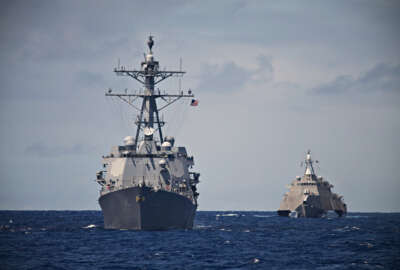Insight by Leidos
DoD Cloud Exchange: Leidos’ Bill Bender on leaning into collaboration
DoD can best make use of tech skillsets available in industry by embracing open architecture development, says Leidos’ Bill Bender at the DoD Cloud Exchange. ...
Among a long list of assignments, Bender was Air Force chief information officer. Now he works with Defense Department organizations, including the Air Force and Space Force, to achieve success in using commercial cloud services, giving him a perspective of cloud efforts from both the DoD and a systems integrator point of view.
Given that perspective, Bender pointed to data management as among the top DoD challenges that cloud computing can mitigate.
“First and foremost, you’ve got this explosion of data happening,” Bender said during Federal News Network’s second annual DoD Cloud Exchange. Whether for maintaining U.S. strategic dominance, improving mission outcomes or modernizing business processes, Defense agencies “believe, and I believe that the insights are there. But they have to curate and manage the data. Cloud infrastructure allows you to do that at speed and at scale,” he said.
Cloud as a tactical advantage
Cloud speed and scale can potentially enable faster decision-making, especially in tactical situations, Bender added.
Of course, between the data and the decision lies some sort of application. Organizations on a cloud journey should start with an analytics application and, as they gain experience, move up the complexity hierarchy to human augmentation and automation applications, and eventually to autonomous systems, Bender advised.
That methodology also gives the organization a chance to mature its technology stack. “A lot of work has to be done to make sure that the various attributes of artificial intelligence in terms of resiliency, accuracy and security are addressed in the tech stack,” Bender said.
Cloud-native development hinges on open architectures
Bender stressed the need for development of cloud native applications using open systems and open architectures.
Open systems enable reuse and interoperability across domains, and it helps the government avoid vendor lock-in. “With nonproprietary solutions, you’re not being locked in to something because you chose to do business with one industry player or another,” he said.
Open approaches underlie the software factories proliferating throughout DoD. Oriented towards frequent, regular delivery of capabilities using agile development, the department’s software factories push agencies past the legacy of long, waterfall development methodologies, Bender said.
“We have to scale our ability to develop software” because software is ubiquitous across every organization and operation, he said.
One key to modernizing the military is to modernize the way organizations develop code for software-defined systems. Industry partners like Leidos can augment the never-ending need for development talent in the government, Bender said. They can infuse the best commercial practices into military requirements. And prime systems integrators can help the government gain access to small business innovators.
“I heard forever — throughout an entire career — how impossible it was to cross the valley of death from commercial into Defense,” Bender said. “The reality is that it’s not a technology problem today. It’s actually more of a cultural and a business process.” There’s no reason for military agencies to cede security needs or mission effectiveness, he said, because open architectures allow best-in-class commercial solutions to plug and play with defense applications.
Where not precluded by the need for classification or secrecy, the department benefits from using commercial cloud services for this work, Bender said. A digitally transformed organization, besides developing mission applications in an agile way, is “a cloud environment where you’re leveraging somebody else’s software provisioned to the Amazons, the Microsofts, the Googles, so that you don’t have that cost of refresh every two or three years. It’s really taking advantage of best commercial practices — their investment for your purposes,” he said.
Thinking bigger than just cloud
In one sense, IT groups responsible for cloud services within DoD should think less in terms of cloud per se and more in terms of enterprise IT as a service (EITaaS). Bender said that idea emerged during his tenure at the Air Force as a way to unburden user organizations of continuing capital costs.
The use case was cybersecurity. EITaaS let the service “put people to what I would call higher-value work around the cybersecurity problem,” Bender said. “In a way, cybersecurity became the silver lining for how we would transition to better IT infrastructure.”
Whether for data services, applications or IT infrastructure, Bender said, the nascent Space Force has a great opportunity to be a federal cloud-native organization. It also has a determined adversary “who has significantly shortened the cycle from concept to launch, and taken the space domain from benign to a threatened environment,” Bender said.
Given that, the service has a particular need to stay agile and responsive, he said, and its efforts to forego data centers and other legacy infrastructure make sense.
To listen to and watch all the sessions from the 2022 Federal News Network DoD Cloud Exchange, go to the event page.
Copyright © 2024 Federal News Network. All rights reserved. This website is not intended for users located within the European Economic Area.
Related Stories
Featured speakers
-

Bill Bender
Senior Vice President, Strategic Accounts & Government Relations, Leidos
-

Tom Temin
Host, The Federal Drive, Federal News Network
On DoD
Upcoming Events
Related Stories
Top Stories

Bill Bender
Senior Vice President, Strategic Accounts & Government Relations, Leidos
Lieutenant General William Bender (USAF, Ret.) serves as the Senior Vice President for Strategic Accounts and Government Relations at Leidos. He strengthens and advances relationships with customers and advances strategic initiatives to foster enterprise growth.
Prior to joining Leidos, General Bender most recently served as Chief Information Officer for the United States Air Force (USAF), where he was responsible for 50,000 cyber operations and support personnel across the globe with oversight for the USAF’s IT investment strategy and a portfolio valued at $17 billion.
General Bender previously was the second highest ranking military officer, based at the United States Embassy in Iraq, serving as the Deputy Chief, Office of Security Cooperation-Iraq with oversight and management of foreign military sales and security cooperation initiatives supporting U.S. diplomatic relations with the government of Iraq. His leadership tenure in the USAF also includes serving as Chief Operations Officer with overall operations, training, and readiness responsibility for 20,000 personnel, as well as Executive Staff Director and Joint Duty Officer to European Command and U.S. Transportation Command Commanders with responsibility for theater-wide and global logistics operations.

Tom Temin
Host, The Federal Drive, Federal News Network
Tom Temin has been the host of the Federal Drive since 2006 and has been reporting on technology markets for more than 30 years. Prior to joining Federal News Network, Tom was a long-serving editor-in-chief of Government Computer News and Washington Technology magazines. Tom also contributes a regular column on government information technology.







